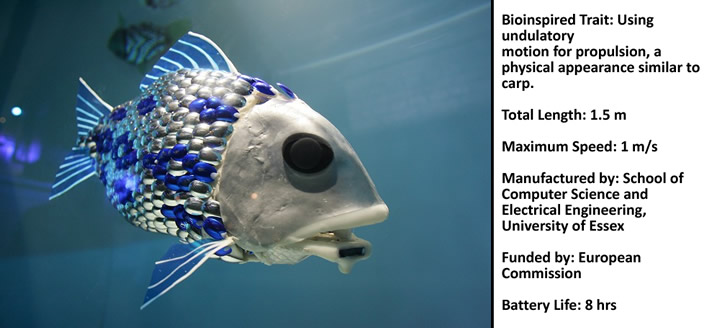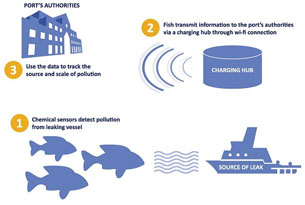
Robofish
 |
Background
Pollution released in to the sea or water ways can have a detrimental effect on water and food sources, and can be harmful to the indegenous animal life. To help detect and track the spread of pollutants released from vessels and pipelines, a robotic fish modeled after a carp has been developed by UK scientists. Modeling the underwater vessel after a fish allows it to blend in with its environment (presenting less of a disturbance to the natural animal life) and utilize a propulsion system nature has proven to be robust and efficient. The robotic carp will be equipped with pollutant sensors and will have autonomous navigation capabilities, unlike previous robotic fish which required remote controls, allowing the fish to act completely independent of human interaction.
How it Works
Robofish utilizes undulatory propulsion as described in the biological propuslion section. To move forward, Robofish oscillates its caudal fin. To turn, Robofish turns its body to one side (making a "C" shape) and then straightens out. These manuevers allow Robofish to navigate a over long distances or in tight spaces as illustrated in the video below
As robofish patrols the waters, chemical sensors allow it to find pollutants in the water. Multiple robofish can communicate with each other using ultrasonics and can transmit information on pollutants to fixed-base observers via Wi-Fi from a central hub as illustrated in the graphic below. Monitoring the pollutant levels in different locations over time provides the information necessary to track pollutant movement and identify pollutant sources.
 |
Future Work
Five robotic carps are being built by the robotics team of Professor Huosheng Hu at the School of Computer Science and Electronic Engineering, University of Essex. Their first test will be during a three-year research project sponsored by the European Commission in which the robotic fish will be released into the port of Gijon in northern Spain. The test will allow the researchers to observe how well Robofish copes with real-world conditions. If the test is successful, the team hopes to place the fish in rivers, lakes, and seas worldwide to help fight water pollution.
Additional information on Robofish can be found here
